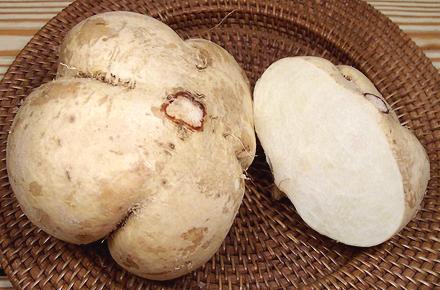Jicama
 [Mexican Yam Bean, Saa Got (China), Man kaew (Thai), Cu san (Viet),
Sankalu (Hindi), Kuzu-imo (Japan), Singkamas (Philippine), Bangkwang (Malay),
Pachyrhizus erosus]
[Mexican Yam Bean, Saa Got (China), Man kaew (Thai), Cu san (Viet),
Sankalu (Hindi), Kuzu-imo (Japan), Singkamas (Philippine), Bangkwang (Malay),
Pachyrhizus erosus]
Jicama (say HEE-ka-mah) is one of only a few bean plants where a root
tuber is the edible part. Immature bean pods are cooked in some countries
but mature pods, beans, leaves and stalks are highly toxic. In the U.S.
only the root tubers are available. The photo specimen (6-1/4 inches
across, 2-1/2 pounds) is deeply lobed, but they are commonly without
lobes.
Erosus came from Mexico, but is now widely grown in Southeast
Asia, the Philippines, China and India. The crisp, white, mildly sweet
flesh is most commonly just peeled and eaten raw, but in Asia it is
often cooked. It retains its crispness but quickly absorbs flavors from
sauces and other ingredients.
More on Beans, Peas and Lentils.
 The Jicamas in the photo to the left are typical of those grown in the
Philippines. They are only about 3 inches in diameter and 4-1/2 ounces,
but are very sweet compared to our Mexican Jicamas. These were purchased
from a Philippine market in Los Angeles (Eaglerock).
The Jicamas in the photo to the left are typical of those grown in the
Philippines. They are only about 3 inches in diameter and 4-1/2 ounces,
but are very sweet compared to our Mexican Jicamas. These were purchased
from a Philippine market in Los Angeles (Eaglerock).
Buying
: Jicamas can be found in just about any market
serving a Latin American or Southeast Asian community, and even in
many regular supermarkets. You want them to be of moderate size because
than can get a little fibrous when very large. They should be very firm
and without discolored or soft spots.
Storing:
Jicama can be kept a couple of weeks
unwrapped in a cool dry place, but once cut should be used within a
week. It won't really keep much longer refrigerated.
Preparing:
Basically, just peel and cut.
Cooking:
In Asian recipes Jicama is often cut into
strips and included in stir fries, where they contribute a crunchy
texture and absorb flavors from the sauce. Outside Asia they are
normally eaten raw in salads and the like.
bp_jicamaz 150211 - www.clovegarden.com
©Andrew Grygus - agryg@clovegaden.com - Photos on this
page not otherwise credited are © cg1 -
Linking to and non-commercial use of this page permitted.
 The Jicamas in the photo to the left are typical of those grown in the
Philippines. They are only about 3 inches in diameter and 4-1/2 ounces,
but are very sweet compared to our Mexican Jicamas. These were purchased
from a Philippine market in Los Angeles (Eaglerock).
The Jicamas in the photo to the left are typical of those grown in the
Philippines. They are only about 3 inches in diameter and 4-1/2 ounces,
but are very sweet compared to our Mexican Jicamas. These were purchased
from a Philippine market in Los Angeles (Eaglerock). [Mexican Yam Bean, Saa Got (China), Man kaew (Thai), Cu san (Viet),
Sankalu (Hindi), Kuzu-imo (Japan), Singkamas (Philippine), Bangkwang (Malay),
Pachyrhizus erosus]
[Mexican Yam Bean, Saa Got (China), Man kaew (Thai), Cu san (Viet),
Sankalu (Hindi), Kuzu-imo (Japan), Singkamas (Philippine), Bangkwang (Malay),
Pachyrhizus erosus]